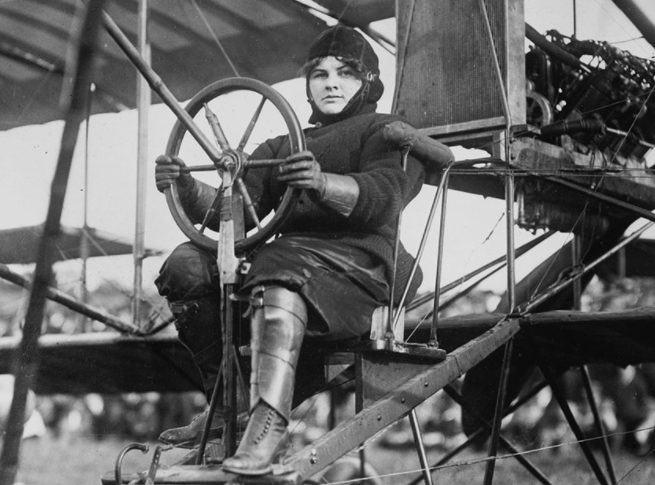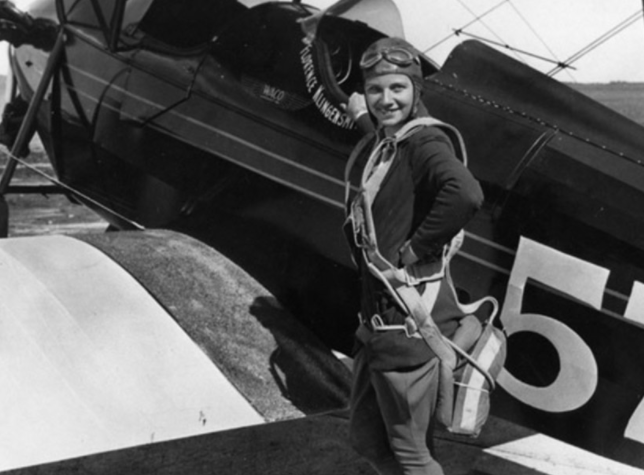America’s First Women Aviators
The homespun movie star and aviation buff Will Rogers couldn’t help laughing as he watched eager pilots rev up to start the biggest women’s air race the nation had ever seen. When a couple of them glanced into their mirrors before climbing into the cockpit, he wisecracked, “It looks like a powder-puff derby to me.”
The nickname stuck, but there was nothing frivolous about the 20 fliers who took off in August 1929 in the first Women’s Air Derby, an eight-day race from Santa Monica to Cleveland that included 15 stops they had to locate using only road maps and dead reckoning. The women all wanted to prove they could fly as fast and as far as men. Likewise, there was nothing frivolous about the rough country and inevitable mishaps that lay ahead. Pancho Barnes collided with a spectator’s car when she landed her Travel Air biplane in Pecos, Texas, and Ruth Nichols crashed into a tractor with her Rearwin K-R in Columbus. Both women walked away with minor injuries, but Marvel Crosson, who had previously spent six years flying in sub-Arctic Alaska and Canada, was not so lucky. She apparently succumbed to carbon monoxide fumes in mid-flight and her body was found in the Arizona desert next to her wrecked clipped-wing Travel Air.
The sentimental favorite of the race was Amelia Earhart. She had made headlines the year before as the first woman to fly across the Atlantic—as a passenger, not a pilot—and would later attain legendary status when she mysteriously disappeared while attempting a solo flight around the world in 1937. Earhart placed a respectable third among the 14 pilots who finished the Women’s Air Derby. But she was far from the most accomplished pilot in the race. That distinction belonged to Louise Thaden, who was already the holder of simultaneous women’s records for speed (156 mph), altitude (20,260 feet) and endurance (22-plus hours), and easily took first in the Air Derby, completing the 2,700-mile zigzag route in a total of 20 hours, 19 minutes flying time. Nor was Earhart the most daring aviatrix of her era. A host of other women, whose exploits are now largely forgotten, were just as brash and, in some cases, a lot more foolhardy.
Earhart had just turned 13 in 1910 when an adventurous young New Yorker named Blanche Stuart Scott headed west to become the first woman to drive a car from coast to coast. It took Scott 69 roundabout days, and her biggest inspiration was not the scenery, but what she saw at Dayton, Ohio. There she met the Wright brothers, teaching flying seven years after they made the first airplane flight at Kitty Hawk, N.C. She was hooked. On returning east, she signed up for lessons with another aviation pioneer, Glenn H. Curtiss.
“In those days, they didn’t take you up in the air to teach you,” Scott recalled years later. “They told you this and that. You got in. They kissed you good-by and trusted to luck you’d get back.”
Blanche Stewart Scott was the only woman to be taught to fly by Glenn Curtiss. (Library of Congress)
On September 5, 1910, Scott climbed into what she called “an undertaker’s chair” in front of “a motor that sounded like a whirling bolt in a dish pan.” The wooden pusher propeller blew her bloomers and three petticoats like sails as she started along the runway. Curtiss had fixed a governor to the engine; she was supposed to practice taxiing only. But either the governor failed to keep the plane from being lifted by a gust of wind—or she intentionally flipped it away—and she was suddenly airborne. She rose 40 feet before settling safely back to earth. It wasn’t much of a flight, being officially undocumented and apparently accidental. But it was first.
Scott’s status as the nation’s lone woman pilot lasted only 11 days. That summer, another New Yorker, a musician, dentist, painter, linguist and trapshooter named Bessica Raiche, was finishing a plane that she and her husband built in their living room. On September 16, without ever taking a flying lesson, she went aloft at Hempstead Plains, Long Island, in her frail, homemade bamboo-and-silk craft. Her flight was the first officially credited to any woman by the Aeronautical Society of America. Before the year was out, she had done it 25 times, cracking up once but walking away intact.
A year after Scott and Raiche took flight, a magazine and screen writer named Harriet Quimby did them one better by becoming the country’s first female licensed pilot. In 1912, to avoid tipping off rivals, she secretly traveled to England to fly across the English Channel. Doing so earned her another women’s first, but in the press her feat was buried by news of the sinking of the great ship Titanic a day earlier.
That did not diminish Quimby’s celebrity value: When the famous aviator Calbraith Rodgers died in a crash, she was hired to replace him as flying spokesman for Vin Fiz, a popular grape soda. Wearing a purple satin costume, she entered the Boston Aviation Meet at Squantum, Mass. Just 11 months after she earned her pilot’s license, she was flying in a new Blériot monoplane with the event’s organizer as a passenger, when the craft pitched forward and tossed both of them to their deaths.
Quimby’s friend, Matilde Moisant, had two brothers who were fliers, one of them killed in a crash. She got her pilot’s license within days of Quimby; the next month Moisant outdid her by reaching 1,200 feet to win an altitude trophy. They toured together, staging one of the first flying exhibitions in Mexico. But Moisant’s air career was cut short after only eight months. When her craft burst into flames on landing at Wichita Falls, Texas, she was pulled out with her clothes afire. Though she was not seriously hurt, she bowed to her family’s wishes and grounded herself.
If frequent crashes in aviation’s first decade made simply flying seem a reckless adventure, World War I lent both romance and cold calculation to the chance of death in the air. Tales of Americans flying for the French in the Lafayette Escadrille, of the German ace Manfred von Richthofen, of the American Eddie Rickenbacker, with their famed Spads, Fokkers and Sopwith Camels, lit the public imagination.
The demands of war had boosted the power and capacity of aircraft as the nation headed into the decade of bobbed hair, bootleg whiskey and, above all, speed. After the Wright brothers wobbled into the air at a calculated rate of 6.82 mph in 1903, the world record was boosted to 68 mph in 1910, to 194 in 1920, and jumped to 407 by 1931. Every one of these records was set by a man. For years, women were thought incapable of piloting the hottest aircraft—after all, planes were rated by horsepower, which suggested to many that they were like mighty steeds that had to be controlled by brute strength.
After learning to fly in France, Bessie Coleman became a star attraction at airshows. (National Archives)
But women like Bessie Coleman proved that indomitable spirit could prevail against prejudice. Born in rural Texas, one of a sharecropper’s 13 children, she struggled until becoming a manicurist in a Chicago barbershop. There she heard so many stories about the exploits of war pilots that she fantasized she could fly too. But she had no money, and even when clients offered to finance her lessons, no U.S. flight schools would take her because she was black. Coleman was undeterred. She studied French at Berlitz, went to Paris for flying lessons, and on June 15, 1921, became the world’s first African-American woman pilot.
Back in the States, she became “Queen Bess,” a star attraction at air shows, doing stunts in mostly war surplus planes like the Curtiss Jenny, pushing them and herself to the limit. In 1926, she went up with her mechanic while preparing for a show at Jacksonville, Fla. She did not hook her seat belt because she was leaning over the side, planning a parachute jump. Without warning, the plane went into a tailspin and she was thrown to her death. A wrench left behind had jammed the controls.
Coleman’s life and death contrasted drastically with that of Earhart, who also became a pilot in 1921. Only a year after getting her license, Earhart set an unofficial women’s altitude record of 14,000 feet. But at first, flying was just a hobby for her; for a while she was a social worker in Boston. Then in 1927, the vast celebration of Charles Lindbergh’s trans-Atlantic solo flight fired her ambition to become just as famous. Success in events like the Women’s Air Derby gave Earhart the will to reach even farther, and in 1932 she set a transcontinental record and finally soloed across the Atlantic.
Her flight from Newfoundland to Northern Ireland took 14 hours, 56 minutes—almost 18 hours and 1,600 miles shorter than Lindbergh’s from Long Island to Paris. But such performances opened the way for women to be admitted at last into some of the big-money races that proliferated in the 1930s. They could even fly specially built speedsters, like the notoriously troublesome Gee Bee series, produced by the Granville brothers of Springfield, Mass., and raced by renowned pilots like Jimmy Doolittle.
Florence Klingensmith was inspired by Lindberg to take up flying. (National Archives)
Florence Klingensmith had to work her way up to flying a Gee Bee. Inspired by a Lindbergh visit to Fargo, N.D., in 1927, she started taking lessons—and helped pay for them with sky diving exhibitions, which almost got her killed. Once licensed as a pilot, she persuaded local businessmen to buy a plane christened Miss Fargo to promote the town, and began breaking records. She easily cracked the unofficial women’s mark of 39 consecutive inside loops, but then Laura Ingalls set a new record of 344, then 850. Klingensmith finally topped her, landing exhausted after going around 1,078 times. That kind of grit got her into top races like the 1932 Nationals, where she won the Amelia Earhart Trophy. The next year, she was the only woman who entered the unlimited $10,000 Philips Trophy race at the Internationals at Chicago.
Her stubby, overpowered Gee Bee No. 7 seemed to be all engine as it whirled around the far pylon and streaked past the grandstand, reaching more than 220 mph between turns. Almost two-thirds of the way through the 100-mile closed course, Klingensmith was in the middle of the pack, ahead of four male pilots, when suddenly a strip of bright red fabric ripped away from a wing panel and floated to earth. For three miles, she fought to hold the Gee Bee steady. Then, at 350 feet, it nosed over and plunged to the ground. She apparently had tried to jump; her parachute was found tangled in the debris.
Klingensmith died because her plane’s owner, in his eagerness to win races, had installed a souped-up 450 hp engine in a craft designed for 215 hp. She was not at fault. Nevertheless, officials used her death as an excuse to bar women from competing against men in sanctioned air races.
That ruling would not last long. In protest, Earhart refused to fly movie star Mary Pickford to Cleveland to open the 1934 National Air Races as planned. Under such pressure, officials relented by 1936, opening the transcontinental Bendix Trophy race to all comers—and with restrictions lifted, women swept to convincing victory. The redoubtable Louise Thaden, flying with Blanche Noyes, finished first. Laura Ingalls, who earlier had flown across the Andes and circled South America, came in second.
Amelia Earhart, flying her twin-engine Lockheed Electra, placed fifth. In that same plane, she would wing out across the Pacific the following year on her way around the world, to be lost in an unsolved mystery that makes her still the most celebrated woman in aviation history.




